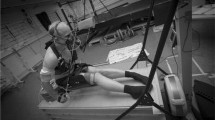Summary
The maximal average power output (\(\bar W_{\max } \)) has been examined in 10 male students, 22 pursuit and 12 sprint cyclists. In 24 of these subjects (8 students, 10 pursuit and 6 sprint cyclists), estimates of the maximal capacity (\(\bar W_{cap} \)) of the short-term anaerobic energy yielding processes were made. The results show that the sprinters had a higher absolute\(\bar W_{\max } \) (1241±266 W) and\(\bar W_{cap} \) (16.7±4.9 kJ) than either the students (1019± 183 W, 14.7±2.8 kJ) or the pursuit cyclists (962±206 W, 14.0±2.9 kJ). However, the differences were removed when the values were standardised for muscle size. In the sprinters theW max was attained at an optimal pedal frequency\(\dot V_{opt} \) of 132±3 min−1 and the estimated maximal velocity of pedalling (\(\dot V_O \)) was 262±8 min−1. The comparable figures in the students and pursuit cyclists were 118±8 min−1, 235±17 min−1 and 122±6 min−1, 242±12 min−1 respectively. The coefficient of variation of duplicate measurements of\(\bar W_{cap} \) was found to be ±9%. Using data of Wilkie (1968) for muscle phosphagen and glycolytic stores (27 mmol · kg−1), it was estimated that the probable efficiency of the anaerobic processes during maximal cycling was 0.22. It was concluded that\(\bar W_{\max } \) and\(\bar W_{cap} \) are largely determined by body size and muscularity. The efficiency of anaerobiosis appears to be of the same order of magnitude as found for oxidative work.
Similar content being viewed by others
References
Coast JR, Welch HG (1985) Linear increase in optimal pedal rate with increased power output in cycle ergometry. J Appl Physiol 53:339–342
Davies CTM, di Prampero PE, Cerretelli P (1972) Kinetics of cardiac output and respiratory gas exchange during exercise and recovery. J Appl Physiol 32:618–625
Davies CTM (1980) Effect of air resistance on the metabolic cost and performance of cycling. European J Appl Physiol 45:245–254
Davies CTM, Sargeant AJ (1975) Effects of training on the physiological responses to one- and two-leg work. J Appl Physiol 38:377–381
Davies CTM, Wemyss-Holden J, Young K (1984) Measurement of short-term power output: comparison between cycling and jumping. Ergonomics 27:285–296
Hermansen L (1981) Effect of metabolic changes in force generation in skeletal muscle during maximal exercise. Ciba Foundation Symposium 82:75–88
Karlsson J (1971) Lactate and phosphagen concentrations in working muscle of man. Acta Physiol Scand [Suppl] 358:1–72
McCartney N, Heigenhauser JF, Sargeant AJ, Jones NL (1983) A constant velocity cycle ergometer for the study of dynamic muscle function. J Appl Physiol 55:212–217
McDonagh MJN, Davies CTM (1984) Adaptive response of mammalian skeletal muscle to exercise with high loads. Eur J Appl Physiol 52:139–155
Margaria R (1976) Biomechanics and energetics of muscular exercise. Clarendon Press, Oxford
Sargeant AJ, Hoinville E, Young A (1981) Maximum leg force and power output during short-term dynamic exercise. J Appl Physiol 51:1175–1182
Tornvall G (1963) Assessment of physical capabilities with special reference to the evaluation of maximal voluntary isometric muscle strength and maximal working capacity. Acta Physiol Scand [Suppl] 201:1–102
Wilkie DR (1960) Man as a source of mechanical power. Ergonomics 3:1–8
Wilkie DR (1968) Heat work and phosphorylcreatine breakdown in muscle. J Physiol 195:157–183
Wilkie DR (1977) Theoretical and practical considerations in harnessing man power. Proc II Man Powered Group Symposium, Royal Aeronautical Society, London
Author information
Authors and Affiliations
Rights and permissions
About this article
Cite this article
Davies, C.T.M., Sandstrom, E.R. Maximal mechanical power output and capacity of cyclists and young adults. Europ. J. Appl. Physiol. 58, 838–844 (1989). https://doi.org/10.1007/BF02332216
Accepted:
Issue Date:
DOI: https://doi.org/10.1007/BF02332216




